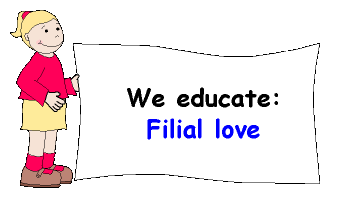|
The first social contact of the child with the world is with his mother, who becomes during the first year of life his main figure of attachment, later this is diversified and there are other figures of attachment (father, grandparents, uncles, etc), though in a general way, the mother continues to be the main figure in the emotional relation established between the child and the adult. Many investigators have suggested that from this first emotional relation depends the good development of the future personality of the child. The filial love, which the child establishes with the attachment figures, the mother and the father and the grandparents should be cultivated; because it is as necessary for the development of the child as the water or the food that he takes; to love and to respect his mother and his family, it is a feeling that grows and is developed whenever there is a relation between the child and his parents, in which the emotional communication, the affection, the help and collaboration of the adult towards the child are priorities The early childhood center has to stimulate in the child this filial love, it has to exalt it and to put it in the highest place, developing in the child this feeling through all the opportunities that the educational process offers in the child’s daily life. |
ACTIVITY
No 1 |
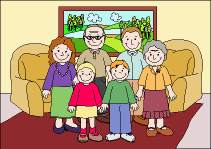 |
Summary of the activity: This activity is about filial love, the first activity will be a conversation betwen the educator and the children about the family, in a second activity a story is told, the children will talk about the story, and finally, in the final part of the activity, they will make drawings dedicated to the members of their families. Objectives: To develop in the children knowledge about the family and the love that there must be among its members. Procedures: Material Resources: Pictures, photos, films of the family members, papers and coloured pencils.
Development of the activity: The educator summarizes this part of the activity emphasizing that all children must love their parents very much, and all the family. 2nd
Part
3rd Part
4th Part |
CRITERIAL
ASSESSMENT |
|||
Observed
conduct |
YES |
NO |
Comments |
They
showed they had knowledge on the members of their family. |
|||
They
made good critics to the negative characters of the story. |
|||
They
identified themselves with the positive character of the story. |
|||
They
related some conducts of the story to their own experiences. |
|||
ACTIVITY
No 2 |
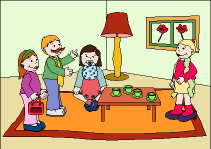 |
Summary of the activity: This is a role play on "The family" and their participants will be all the children who wish to take part in it. Objectives: To develop in the child experiences about good relations and love towards the family. Procedures:
Material Resources: A game corner where there are all the necessary things so that the children can play the family: furniture, household equipment, etc.
Development of the activity: In the course of this conversation the educator will ask questions to the children so that they describe their experiences about their family.
2nd Part
3rd Part Finally the educator will summarize the conversation systematizing what they learned about the family and the love that the children have to give to their parents and other family members. |
CRITERIAL
ASSESSMENT |
|||
Observed
conduct |
YES |
NO |
Comments |
They
developed the argument of the game until the end. |
|||
They
developed the actions corresponding to the role. |
|||
They
made commentaries about the importance of good familiar relations. |
|||
They
knew how to solve the conflicts during the game. |
|||
They
needed the help of the educator to solve the conflicts during the game. |
|||
ACTIVITY
No 3 |
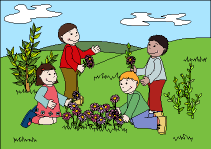 |
Summary of the activity: The class will go for a stroll to gather materials from nature and later to make a pretty decoration to give to their mothers. Objectives: Procedures:
Material Resources: xxxxxxx
Development of the activity:
1st Part
2nd Part
3rd Part
4th Part |
CRITERIAL
ASSESSMENT |
|||
Observed
conduct |
YES |
NO |
Comments |
They
needed help to make the decoration. |
|||
They
felt satisfaction to make flatteries to give to their mothers. |
|||
They
made verbal manifestations of their love to their mother and their
family. |
|||
ACTIVITY
No 4 |
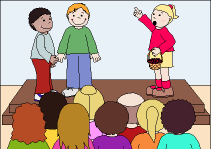 |
Summary of the activity: The children will learn poems and songs that they will later recite and sing in an act or party in the school dedicated to the family. In this activity they will also give their family the decorations that they made for them. Objectives: To develop in the children feelings of love towards their family. Procedures:
Material Resources: Poems and songs, a cassette recorder.
Development of the activity: Next, the educator, along with the children, decorates the hall for the party with their parents.
2nd Part
The children will sing the songs selected by the educator and that will be dedicated to the family. In this party the children who made decorations with materials from nature will hand them out. The educator will summarize this part of the activity emphasizing that not only on that day, but every day, the children will entertain their parents and their family with much love. |
CRITERIAL
ASSESSMENT |
|||
Observed
conduct |
YES |
NO |
Comments |
They
expressed positive emotions for the poem dedicated to their mothers. |
|||
They
showed positive emotions when singing the songs dedicated to their
parents. |
|||
They
felt satisfaction when entertaining their parents. |
|||
They
made verbal manifestations of the affection to their parents. |
|||
ACTIVITY
No 5 |
 |
 |
 |
||
Summary of the activity: The educator will create a circuit in which he will hide objects that must be found by the children to give to their parents, for this he will make a map of the place. Objectives: To develop in the children feelings of filial love. Procedures:
Material Resources: Diverse objects that will serve as treasures: shells, coloured stones, flowers, pictures, drawings, book markers, cards, etc. Several maps made by the educator.
Development of the activity:
2nd Part
3rd Part |
CRITERIAL
ASSESSMENT |
|||
Observed
conduct |
YES |
NO |
Comments |
They
did well all the required movements to find the treasure. |
|||
They
needed help to make the required movements to find the treasure. |
|||
They
looked for the objects to give with interest. |
|||
They
were touched when they found the hidden treasure. |
|||
They
helped each other mutually in the search. |
|||
ACTIVITY
No 6 |
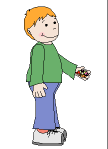 |
Summary of the activity: To end the block of activities, the educator can make an activity in which he shows a situation to the children to evaluate those aspects of the block that needs to be verified, or to determine to what extent they have been understood and internalized by the children. Objectives: To verify by means of a critical experience the development of the feeling of filial love from the children to their parents. Procedures:
Material Resources: A bag of sweets.
Development of the activity:
2nd Part All these conducts will be registered by the educator in a notebook, but one will make sure that the children do not realise that they are being observed.
3rd Part It is important that the educator when handling the answers in the group does not adopt a punitive or depreciative position, and he will let the children express their criterion. The educator has to evaluate the answers given by the children. One assumes that most of the children will want to eat the sweets since at this age it is not possible to expect that they have the necessary will to do it, for that reason the fact of eating them or not is not the unique criterion to evaluate filial love, if some kept them, well; but if not, it is a good thing that the conflict between keeping them or eating them was created. The conflict is in fact an indicator of the development of the feeling of filial love towards their parents. The children’s answers, the reason why they did not keep the sweets, will also serve as an evaluation criteria. |
CRITERIAL
ASSESSMENT |
|||
Observed
conduct |
YES |
NO |
Comments |
They
have enriched the notion that they had at the beginning of the activities
of this block on filial love. |
|||
When
finalizing the block they seemed to have formed notions on filial
love. |
|||
They
only seem to have some notions on the filial love. |
|||
They
reflected feelings of love for their parents and family. |
|||
They
could control their desire and they gave all the sweets to their parents. |
|||


